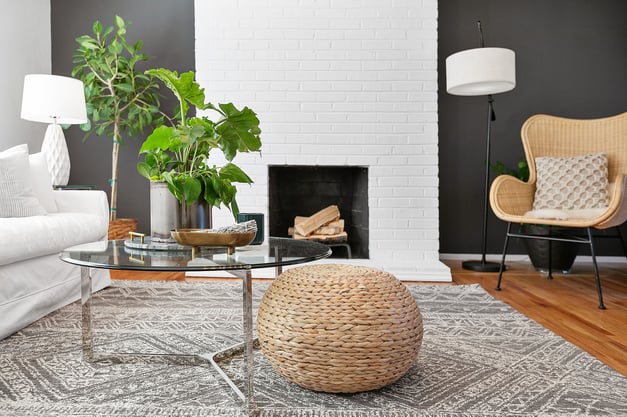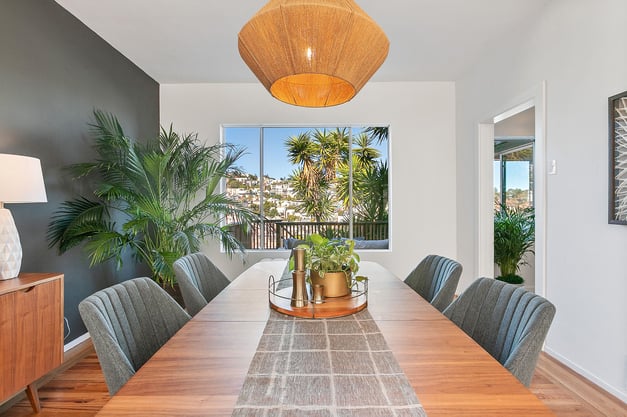Humans have always been drawn to and inspired by nature. Sitting by a river, listening to the leaves rustle in the trees in your backyard, taking a breath of fresh air – nature has a way of improving our physical and mental health. Biophilic design embraces the human-nature connection by incorporating natural elements into your home.
Whether you are building a new house or decorating your current one, there are a few ways to enjoy the many physical and mental health benefits of a greener space.
What is biophilic design?
Although biophilic design sounds straightforward, it can be difficult to incorporate into your home. Part of this is because scientists don’t fully understand the biological reasoning behind our connection to nature, and part of this is because home design on its own is complicated.
Stephen Kellert, a social ecologist, outlined a useful framework for biophilic design. First, it’s important to know that biophilic design has two main ideas: the organic, or elements that remind us of nature, and the place-based, or elements that connect the home to its local environment.
Key elements of biophilic design
According to Kellert, there are six key elements of biophilic design:
1. Environmental features
Embrace the human-nature connection by incorporating pieces of the natural world, like plants, animals, and organic materials. Colors, water, and air flow are also important to consider. Letting ivy grow over the front of your home is one way to embrace environmental features.
2. Natural shapes and forms
If you’re building a new home, consider designing the exterior to imitate the shapes and forms found in nature. You can incorporate animal motifs like hives and webs both inside and outside the home. Avoid right angles and embrace natural curves.
3. Natural patterns and processes
Although this element might sound similar to shapes and forms, this is more about using natural properties to enhance the built environment. If you go outside, you’ll instinctively respond to the variations and richness of detail you can find in a park or hiking trail. To use this element, think of bringing that same richness into your home.
4. Light and space
Natural and filtered daylight come with a number of benefits for our physical and mental health. What’s more natural than your circadian rhythm? Another way to approach light is to consider the relationship between light and shade, as well as the uses of reflected light. Space gives you a sense of openness. It’s especially important to consider transitional spaces. How do you want your home to feel as you step out onto the porch or other outdoor living space? How does that outdoor living space embrace its natural surroundings?
5. Place-based relationships
This element is where culture meets ecology. People have deep, strong connections to certain places. These connections go deeper than “I have family there” or “This is where I grew up.” We have real biological ties to geographic and historical features, local ecosystems, and landscapes. By embracing this emotional connection with nature at home, you’ll feel more stewardship and pride in your property.
6. Evolved human-nature relationships
This element focuses on the fundamental aspects of our relationship with nature. Nature offers a sense of safety, protection, balance, curiosity, and exploration. A biophilic home offers those same senses.
How to incorporate biophilic design in your home
Now that you know the basics, you can do a few things to feel the soothing effects of nature at home. Whether you focus on organic architecture or interior design, there are a few simple things you can do to incorporate this soothing home aesthetic.
Plan ahead
Before any major changes to your home, it’s important to plan ahead to ensure your project goes smoothly.
First, leave yourself time to find licensed professionals who can provide references for their work. This will help ensure you end up with a well-crafted design that you can enjoy for years to come. Plan to ask at least 3 pros for quotes and references to ensure you’re getting the right price from the right person.
Second, it’s always a good idea to set a budget for your project. When you’re redesigning a room or your entire house, it’s all too easy to go wild purchasing decor and doing extra projects for the perfect look. Set a budget and track your expenses to ensure you don’t end up with debt (or at least more debt than you signed up for).
Last and most important, be sure to check in with your home insurance agent. This is because some renovations can increase the value of your home and affect your insurance coverage. Additionally, some renovations may require permits or inspections, and your insurance company may require proof of these before renewing your policy. If you don’t inform them about your renovations, your coverage could be voided, or you may not have enough coverage to protect your investment. It’s always best to be transparent with your insurance company about any changes to your property, so they can help you adjust your coverage accordingly.
Let the natural world in
This might be the easiest thing you can do to incorporate biophilic design: open your windows. Let fresh air and the sounds of nature into your home. Listen to birds singing, rain falling, or even just the wind rustling leaves on a tree. Breathing in fresh air is good for your immune system function, and fresh air can even improve your mood.
Maximizing the amount of natural light in your home is a good idea, too. Consider adding a skylight or opening curtains and blinds in the morning. Replace the black door with sliding glass doors. If you have a screen door or storm door in the front, you can even leave the front door open while you’re home to catch some afternoon light and a little extra vitamin D.
Add some houseplants indoors
Bringing in houseplants is a great way to build on the human-nature connection. Indoor plants have been shown to reduce stress levels and purify indoor air. Houseplants can even help you stay focused and enjoy better cognitive function.
Of course, if you’re not an avid gardener, make sure to invest in easy plants. ZZ plants, pothos, and sansevieria are all great options if you’re just stepping into the world of indoor plants. These plants also do well without a lot of light. Keep in mind how much light you have in your home, and ask the garden supply center workers for advice on which plants might be best for your space. Just because a particular plant is popular on Instagram doesn’t mean it’ll thrive in your home’s environment.
Incorporate natural materials
Embrace natural materials like wood and stone. Wood and stone veneer give the same effect at a lesser cost. Consider natural finishes that let you see the organic patterns in wood flooring. You can DIY some of these projects or bring in a local handyman to achieve that natural look.
Accent pieces in cotton or natural linen bring texture and an organic look to any room. A live-edge dining room table is a great way to embrace biophilic design in your living space. Do your best to choose sustainable materials that are responsibly sourced. Embracing biophilic design means embracing nature and being a steward of the land, so keep that in mind when shopping for materials as well.
Use natural colors
We are drawn to greens, blues, and browns. These hues have a calming effect on our minds and bodies. Choosing colors found in nature will give your home a cohesive look, even if you have a wide variety of colors and textures from room to room. Take a cue from the great outdoors; flowers come in bright colors, but the backdrop is usually green, brown, or blue. Use brighter colors in small doses for a natural effect.
Connect to the outdoors
We’ve talked about bringing the outdoors in, but you can do a few things to make that transition outdoors seamless. If you have a deck or patio, create an outdoor living space with comfy patio furniture and an outdoor area rug.
Bring in some potted plants, a plant cover lawn, or a water feature for a smooth transition from your indoor to your outdoor living space. By making an outdoor living space, you’re gaining square footage for entertaining while maintaining a smooth transition from your home to the yard or garden.
Our top 3 biophilic home projects
If you’re looking for more inspiration, there are three simple DIY projects you (or a local handyman) can do to incorporate biophilic design in your home:
- A living green wall: Imagine a wall covered in your favorite plants, so your home looks like a jungle. You can do this project indoors or outdoors. Living walls are modular systems attached to walls to hold different plants. Some come with interior integration, and others are as simple as turning a wood pallet into a planter. You can even buy wall-mounted planters and use them to hold vining houseplants, like pothos, to achieve a similar effect.
- Natural wood accent walls: This project allows beginner DIY homeowners to add some dimension and texture to their walls. Measure your wall, so you know how much wood to buy, and then sketch a pattern. Use four boards to frame the wall. You can make a grid or panel pattern on the wall from there. Then, paint or stain the wood pieces.
- Tabletop indoor fountains: Enjoy the soothing flow of water in your home with a simple tabletop fountain. You can purchase a tabletop fountain online or make your own to save a little money. Invest in a pretty, watertight bowl and some decorative rocks. All you have to do then is buy a small fountain pump and fill the bowl with water and rocks. If you have a larger table, consider using a planter and a bowl to make tiers. Some fountain pumps come with remote controls, so you don’t have to worry about leaving the fountain running.
Biophilic design benefits
In the early days of the pandemic, plenty of people took the time to declutter their living spaces and make them more functional. Your mental state is often a direct reflection of your surroundings, and by restoring the human nature connection with nature at home, you’re likely to notice several benefits to your physical and mental health.
Biophilic design restores our essential harmony with nature in the built environment. People spend the majority of their time indoors, and that time has likely increased since the start of the pandemic. Creating a calming environment in your home might be more important now than ever.
Mind restoration and productivity
The 2015 Human Spaces report found that office workers whose offices incorporated natural elements had a 15% higher well-being score than offices without natural elements like plants. Plants improve air quality and help us feel connected to the outdoors, even if we’re stuck inside surrounded by screens most of the day.
Bringing elements of nature into your home can help lower blood pressure levels and heart rates. Your home should be a calming, restorative place to retreat from work, school, and the pressures of the outside world.
Even living near a park can boost your mental health – and increase your feelings of security. Neighborhoods with access to nature report less crime and enjoy increased property values compared to communities encased by other buildings or businesses.
Advances in technology
Many studies reveal how vital nature is to our well-being on a biological level. There are LED lights designed to follow the natural pattern of daylight, which improves focus levels and regulates circadian rhythms. Due to these light patterns, you’ll experience better sleep and enjoy more energy throughout the day.
Vertical green walls have been around for a while, but new technology helps these plants stay alive and thrive longer than before. Irrigation improvements keep these plants healthy so that you can enjoy nature indoors and outdoors.
Exterior biowalls with algae are being studied in the fight against climate change. Plants naturally remove carbon dioxide from the air and release oxygen. Scientists hope to imitate this process to remove pollutants from our atmosphere.
Improve your bond with nature
Ultimately, biophilic design reminds us that we are part of something bigger. The trees, flowers, and animals we see — we’re all connected. It’s easy to say that being more energy efficient is important. Still, incorporating natural elements into your home design makes you more likely to feel why protecting nature is essential.
Green architecture has decreased the environmental impact of new construction homes and office buildings. We are enjoying increased energy efficiency and better water usage. Biophilic design keeps people motivated to be stewards of the land.
Final thoughts
By bringing in some elements of the natural world, your home can become the soothing, restorative retreat of your dreams. Whether you are an avid gardener, just getting into houseplants, or inspired by the beautiful colors of the ocean, you’ll enjoy reconnecting with the beautiful planet we live on — all from the comfort of your home

















